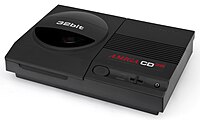CD³²
| CD³² | ||
|---|---|---|
|
|
||

|
||
| Manufacturer | Commodore | |
| Type | stationary game console | |
| generation | 5th generation of consoles | |
| publication |
|
|
| Main processor | Motorola 68EC020 (14 MHz) | |
| Graphics processor | AGA chipset | |
| Storage media | CD-ROMs | |
| predecessor | CDTV | |
The CD³² was one of Commodore International , based on the Amiga 1200 developed game console of the fifth generation of consoles with CD-ROM drive - and the successor to the CDTV . It was the first game console on the European market with 32-bit architecture and was intended to compete with Philips ' CD-i . The Amiga 1200 base was reduced to what was necessary for playing and a CD drive was added. The CD³² could be expanded to a full-fledged Amiga or, alternatively, to a video CD player via a slot on the back .

description
Instead of the Gayle system controller used in the Amiga 1200, the CD³² has a special custom chip, the Akiko , which, among other things, should also simplify PC conversions and enable more complex 3D graphics. 3D graphics are traditionally more difficult to handle on Amigas than usual, as the frame buffer works in the unsuitable bit plane mode. In the so-called chunky mode (which has meanwhile become established across all systems), all the bits that make up the color of a pixel are stored one after the other in the memory. In bitplane mode, on the other hand, several black and white images (“planes” with one bit per pixel each) are stored in the memory independently of one another. If you imagine these bitplanes superimposed, you can read the binary value of a pixel color from top to bottom. Using software to change a single pixel in this mode is time-consuming, and in order to display 3D graphics, each pixel of the image had to be set individually using software. This is why the Amiga ultimately established itself to calculate 3D graphics using a chunky frame buffer and then convert it into a bitplane frame buffer - the term chunky-to-planar conversion has become established for this, and this is exactly what Akiko implements -Chip (among its other functions) in hardware.
The hoped-for PC conversions did not materialize, however, and the main processor, a 68EC020 clocked at 14 MHz, was not sufficient without further hardware support to motivate the development of 3D games - this function of the Akiko remained unused with a few exceptions.
The CD³² was part of a series of consoles that could not hold their own on the market. Commodore had envisaged the Sega Mega-CD as its main competitor. The 3DO and the Atari Jaguar also appeared during the lifetime of the CD³² . The CD³² was Commodore's last hope to avoid bankruptcy, but it did not succeed. In the end only very few exclusive titles appeared on the CD³². Most of the games were conversions from Amiga 1200 or even Amiga 500 titles (see list of Amiga CD32 games ).
In the USA the CD³² could never be officially sold because of a license dispute, and so the devices remained in the factories in Asia. Some dealers from Asia have been selling some remaining stock since 2006 through a well-known auction house. The CD³² was one of the last hardware products that Commodore released before it went bankrupt.
Technical specifications
- Motorola 68020 (68EC020RC16) with 14.18 MHz (PAL version) or 14.28 MHz (NTSC version)
- 2 MB chip RAM
- 1 MB ROM with Kickstart ROM 3.1 and integrated cdfs.filesystem
- 1 KB Flash ROM for saving games
- AGA - Chipset
- CD-ROM double-speed drive with audio CD playback option (software integrated in the ROM)
- Akiko chip, which was responsible for the CD-ROM drive plus other features (see above)
- 24-bit color palette (16.7 million colors)
- up to 256 colors simultaneously in palette modes
- 262,144 colors simultaneously in HAM8 mode
- Resolution up to 1280 × 512i (more with overscan )
- Amiga OS 3.1
- 4 × 8-bit audio channels
- Gamepad, serial port, 2 game ports, interfaces for a keyboard
connections
- S-video output (4-pin mini-DIN )
- Composite video output
- High frequency audio / video output (antenna)
- Audio output (2 × cinch and 3.5 mm stereo jack socket )
- Keyboard (6-pin mini-DIN)
- 2 × mouse / joypad ports ( D-Sub 9)
- RS-232 serial / AUX port (6-pin mini-DIN)
- Expansion slot: 182-pin connector for MPEG - Cartridge or third-party adapters as the SX-1 or SX32 Expansion cartridges.
Others
Due to the installation of inferior electrolytic capacitors and their age, it is advisable to replace them in good time before they burst or leak and thus damage other parts.
See also
Web links
- CD32-Allianz - Homepage all about CD³², CDTV and CDTV / CR
- Fan page for the CD³² with lots of pictures, downloads and information
- More information and photos about the CD³²
- Repair information on various Amiga models and Elko parts lists


